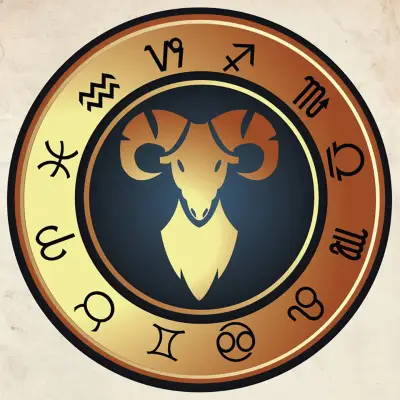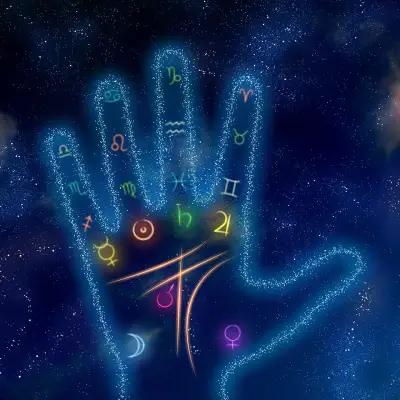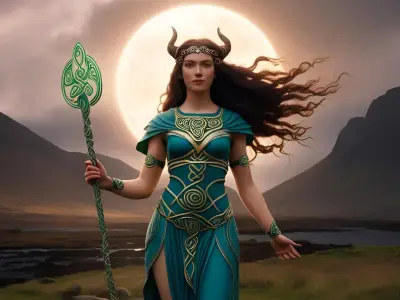Greek mythology is full of fascinating tales where heroes battle fearsome creatures, and gods interact with mortals. It's a world that has captivated our imaginations for centuries. In this exploration, we will uncover some of the most famous ancient Greek monsters and creatures, and discover the intriguing stories that have become legendary.
Jump to:
- The Minotaur: The Scariest Greek Monster
- Medusa: The Gorgon with a Deadly Gaze
- The Hydra: The Multi-Headed Serpent
- Cerberus: Guardian of the Underworld
- The Sirens: Enchanters of the Sea
- The Harpies: Winged Spirits of Punishment
- Chimaera: The Fire-Breathing Hybrid
- The Sphinx: The Riddler of Thebes
- Scylla and Charybdis: Terrors of the Sea Strait
- Typhon: The Father of All Monsters
- Echidna: Mother of Monsters
- The Nemean Lion: Hercules' First Labour
- The Griffin: The Majestic Beast
- Greek Monsters in Mythology: Frequently Asked Questions
- Study Greek Mythology for £29
Recommended for you!
Best Sellers1. The Minotaur: The Scariest Greek Monster
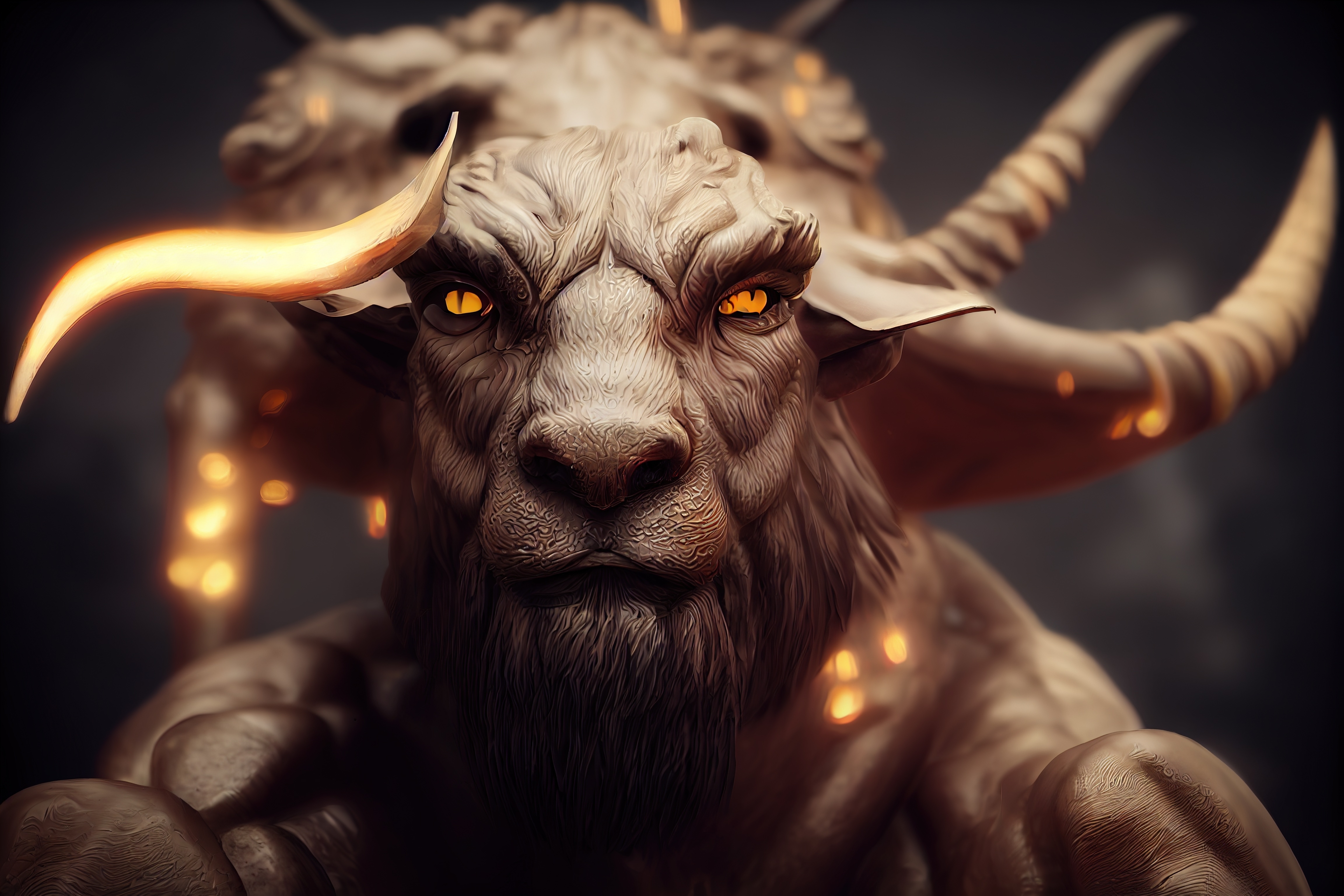
The legend of the Minotaur stands as one of the most intriguing and chilling tales in Greek mythology. This monstrous being, dwelling in the heart of Crete's Labyrinth, symbolised terror, representing power, punishment, and ingenuity.
Birth of the Minotaur: A Tale of Punishment and Power
The Minotaur's story begins with an act of divine retribution. King Minos of Crete, having received a magnificent bull from the sea god Poseidon, was expected to sacrifice the animal in honour of the god. However, captivated by the bull's majestic beauty, Minos chose to keep it, sacrificing another animal in its stead.
Angered by this disrespect, Poseidon cursed Queen Pasiphae, Minos' wife, causing her to fall deeply in love with the bull. This unnatural union led to the birth of the Minotaur, a creature with the body of a man and the head of a bull, a living testament to the consequences of defying the gods.
The Labyrinth: A Masterpiece of Confinement
To hide this embodiment of his shame, King Minos commissioned Daedalus, a master craftsman, to construct the Labyrinth. With its twisting and turning pathways, this complex maze was designed to be nearly impossible to navigate.
Here, the Minotaur was confined, hidden from the world, becoming a creature of legend and fear. The Labyrinth itself became as much a part of the myth as the Minotaur, symbolising the perplexing nature of human emotions and decisions.
The Tribute to the Beast
The story of the Minotaur also includes a grim ritual. As part of his dominance over Athens, King Minos demanded a tribute of seven young men and seven young women every seven or nine years (accounts vary). These unfortunate souls were sent into the Labyrinth as food for the Minotaur, a constant reminder of Minos' power.
The Hero Theseus and Ariadne's Aid
Enter Theseus, the prince of Athens, who volunteered to be part of this sacrificial group with a bold plan to kill the Minotaur. In Crete, Theseus met Ariadne, King Minos' daughter, who fell in love with him. She provided Theseus with a sword to fight the Minotaur and a ball of thread (Ariadne's thread) to navigate the complex Labyrinth. This thread, symbolising love and intelligence, allowed Theseus to find his way back after defeating the Minotaur, highlighting the themes of ingenuity and bravery often celebrated in Greek myths.
The Minotaur's Death and Legacy
The confrontation between Theseus and the Minotaur is a climactic moment in Greek mythology. Theseus, using his strength and the sword given by Ariadne, managed to slay the beast, symbolising the triumph of human courage and wit over primal fear and chaos. The death of the Minotaur ended the tributes, liberating Athens from its subjugation to Crete.
The Minotaur's legacy is powerful, embodying the themes of punishment, power, intelligence, and the complex relationship between humans and the divine. It reminds us of the consequences of mistreatment and the struggle between barbarism and civilisation.
2. Medusa: The Gorgon with a Deadly Gaze
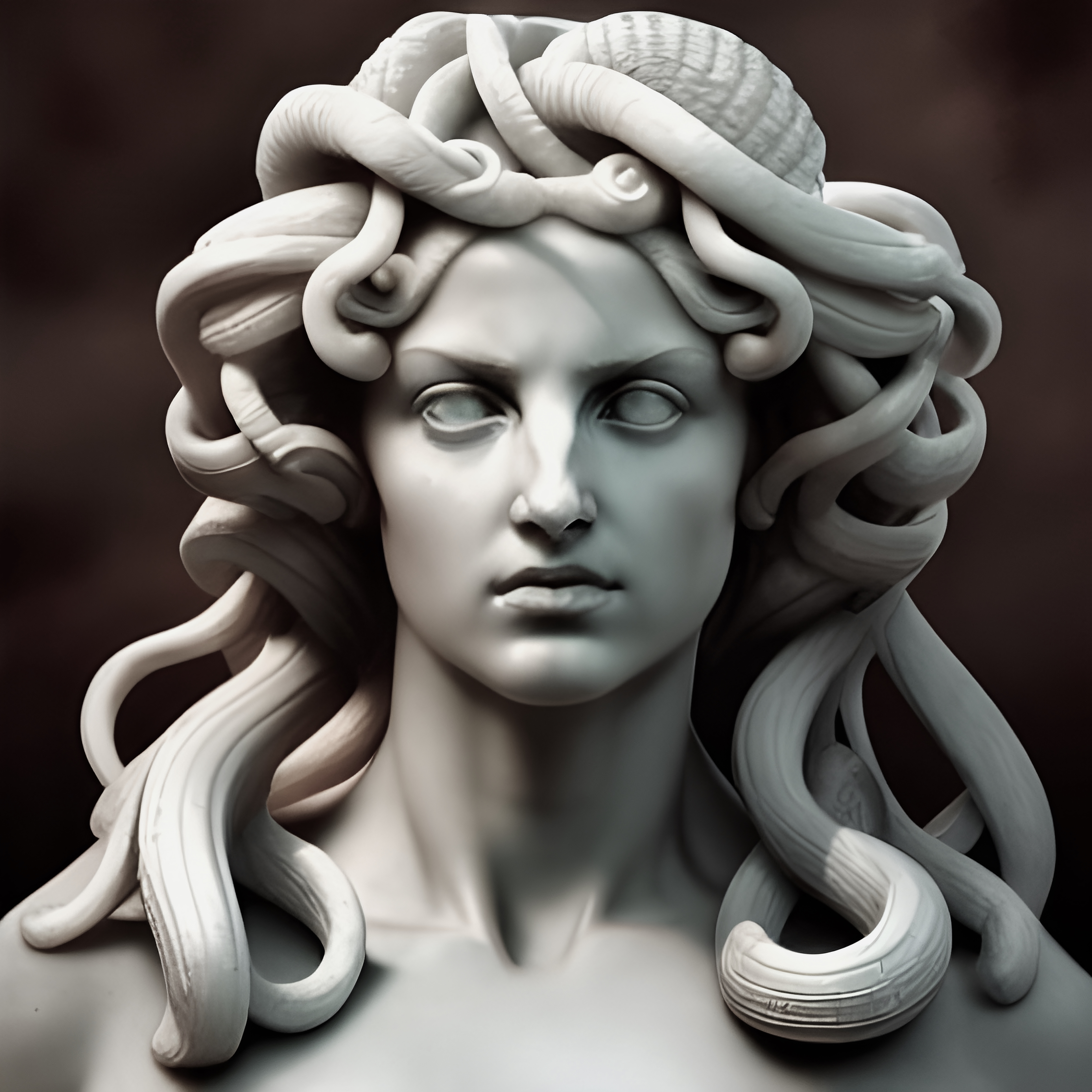
As one of the three Gorgon sisters, Medusa is best known for her hair of writhing snakes and a gaze that turned those who looked upon her to stone. Her story, from a beautiful maiden to a monstrous figure, embodies themes of transformation, power, and the complexities of divine intervention.
Medusa's Origin: A Tale of Beauty and Curse
Medusa was not always the fearsome creature she was widely known to be. Originally, she was a beautiful maiden with a particularly striking feature – her magnificent, long hair. It was this beauty that, according to one version of the myth, led to her downfall. When Poseidon wooed her in Athena's temple, the offended goddess transformed Medusa's beautiful hair into serpents. She made her face so terrible to behold that the mere sight of it would turn onlookers to stone.
A Symbol of Divine Punishment and Protection
According to some interpretations, Athena intended to guard Medusa against future harm. However, this 'protection' came at a great cost, as Medusa was exiled and turned into a monster, feared and shunned by all. This dichotomy makes Medusa's story one of the most complex and discussed in Greek mythology, touching on themes of victimisation, power, and the unpredictable nature of the gods.
The Deadly Gaze: Medusa's Infamous Power
The most defining aspect of Medusa is her deadly gaze. This power to petrify anyone who looked directly at her became both her greatest weapon and her curse. It symbolised a loss of agency and a transformation from a beautiful woman to a being defined solely by the fear she invoked in others.
Perseus and the Slaying of Medusa
The climax of Medusa's story comes with her encounter with Perseus, one of Greek mythology's most celebrated heroes. Tasked with killing her, Perseus used a mirrored shield given to him by Athena to view Medusa's reflection, avoiding direct eye contact. With the help of other gifts from the gods, including Hermes' winged sandals, Hades' helm of invisibility, and a harpe (a curved sword), Perseus beheaded Medusa while she slept. This act of slaying Medusa is often interpreted as a conquest of reason and bravery over monstrousness and chaos.
Medusa's Legacy: A Symbol of Mysterious Power
Even after her death, Medusa's head retained its petrifying power and was used by Perseus in further adventures. Eventually, he gave the head to Athena, who placed it on her shield, the Aegis. Medusa's head thus became a symbol of protection and divine power, used to ward off evil.
3. The Hydra: The Multi-Headed Serpent
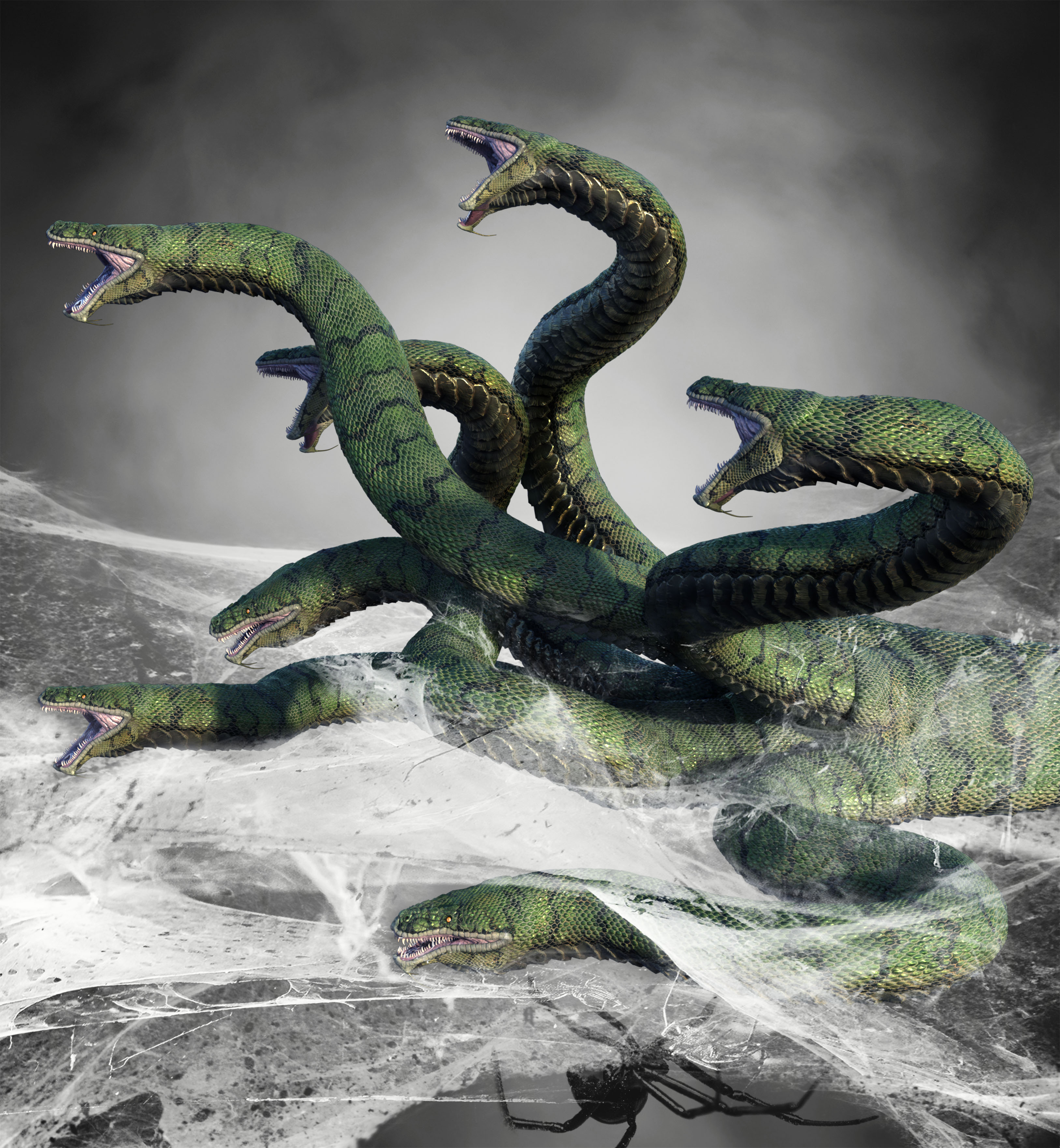
The Lernaean Hydra is a monstrous water serpent famous for its regenerative abilities. He presented a unique and formidable task for Hercules, one of the greatest heroes of Greek mythology, during his legendary Twelve Labours. The Hydra's story is rich in symbolism and metaphor, reflecting the complexities of overcoming great obstacles.
Origin of the Hydra: A Spawn of Echidna and Typhon
The Hydra was believed to be the offspring of Echidna and Typhon, two fearsome and legendary creatures in their own right. Born in the swamp of Lerna, which was said to be an entrance to the Underworld, the Hydra embodied the terror of the unknown and the power of nature's wrath.
The Challenge of the Hydra
The Hydra's most distinguishable feature was its numerous heads, making it one of the most terrifying ancient monsters from Greek Mythology. The exact number varies in different accounts, but commonly, it is said to have had nine. The true terror of the Hydra lay in its ability to regenerate – when one head was cut off, two more would spring up in its place. This made the Hydra seem invincible, with the task of defeating it seemingly impossible. The creature also had the power to release deadly poisonous fumes, adding another layer of danger to the challenge.
Hercules' Battle with the Hydra
Hercules' encounter with the Hydra was a key moment in his series of Twelve Labours. Physical strength was not enough to defeat this monstrous serpent; it required strategic thinking and resourcefulness.
Hercules, accompanied by his nephew Iolaus, quickly realised he needed a new approach after cutting off one of the Hydra's heads only to see more grow back. Iolaus came up with the idea of using fire to cauterise the neck stumps after each head was cut off, preventing the growth of new heads. This tactic reveals the theme of intellect over brute strength, a common motif in Greek mythology.
The Significance of the Hydra's Defeat
The defeat of the Hydra was significant in several ways. Firstly, it demonstrated Hercules' ability to adapt and overcome seemingly impossible odds. Secondly, it showed the importance of assistance and clever thinking, as Hercules' success was partly due to Iolaus' help. Finally, the Hydra's defeat symbolised the triumph of order over chaos, a recurring theme in many mythological tales.
The Hydra's Place in Greek Mythology
The Hydra remains one of Greek mythology's most iconic creatures, symbolising the idea that some challenges in life can grow more complex and daunting when tackled head-on, requiring cleverness and adaptability to overcome. The tale of the Hydra's defeat is a metaphor for the trials and tribulations you might face, reinforcing the idea that perseverance and intelligence are key to overcoming difficult situations.
4. Cerberus: Guardian of the Underworld
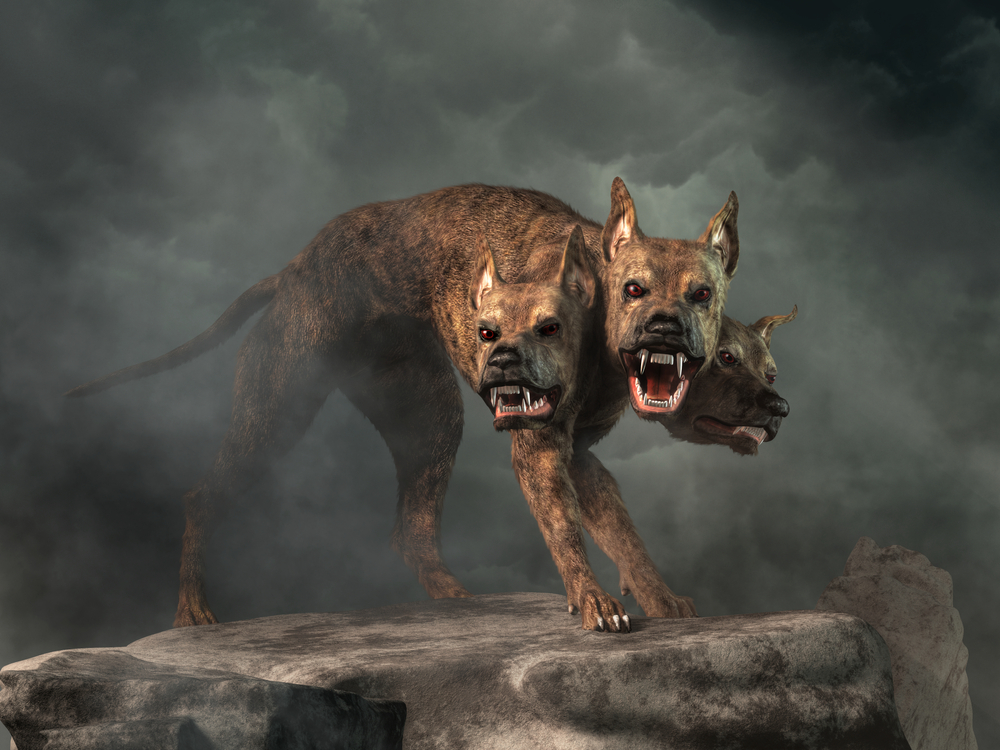
Cerberus, the formidable three-headed dog of Greek mythology, guards the mysterious and feared underworld. His role as Hades' accomplice makes him one of ancient Greek lore's most iconic and enduring figures. The story of Cerberus symbolises the boundary between life and death, the known and the unknown.
The Fearsome Guardian
Cerberus, often depicted with three heads, was said to have a serpent for a tail and snakes protruding from various parts of his body, adding to his terrifying appearance. His primary duty was to guard the gates of the underworld, ensuring that the dead could not leave and the living could not enter without the permission of Hades, the god of the underworld.
This made him an essential figure in the Greek conception of the afterlife, a guardian of the natural order between the living and the dead.
The Symbolism of Cerberus
Cerberus represents the ultimate barrier, both physical and metaphorical. He is the final obstacle that souls encounter before entering the world of the dead, symbolising the inevitable transition from life to death. In a broader sense, Cerberus embodies the idea of boundaries and the importance of respecting limits, whether they are set by nature, the gods, or society.
Hercules and the Capture of Cerberus
The tale of Hercules capturing Cerberus as his final and twelfth labour is a highlight in Greek mythology, showcasing the hero's extraordinary bravery and strength. This daunting task, set by King Eurystheus, required Hercules to enter the underworld and face and overcome the fearsome guardian. Hercules managed to overpower Cerberus, using his immense strength and his wit, according to some versions of the story.
In some accounts, Hercules did not use brute force but relied on his warrior skills to subdue Cerberus without harming him. This act of capturing Cerberus without using weapons and returning him safely demonstrated Hercules' ability to conquer even the most formidable challenges through strength, courage, and respect for the rules of gods and nature.
The Impact of Cerberus in Mythology and Culture
The story of Cerberus and his encounter with Hercules has been told through centuries, symbolising the hero's journey into the unknown and his confrontation with death. Cerberus has become a cultural symbol of guardianship and the formidable barriers you must overcome. He is often referenced in literature and art as representing the obstacles that guard the most valuable and secretive things.
5. The Sirens: Enchanters of the Sea
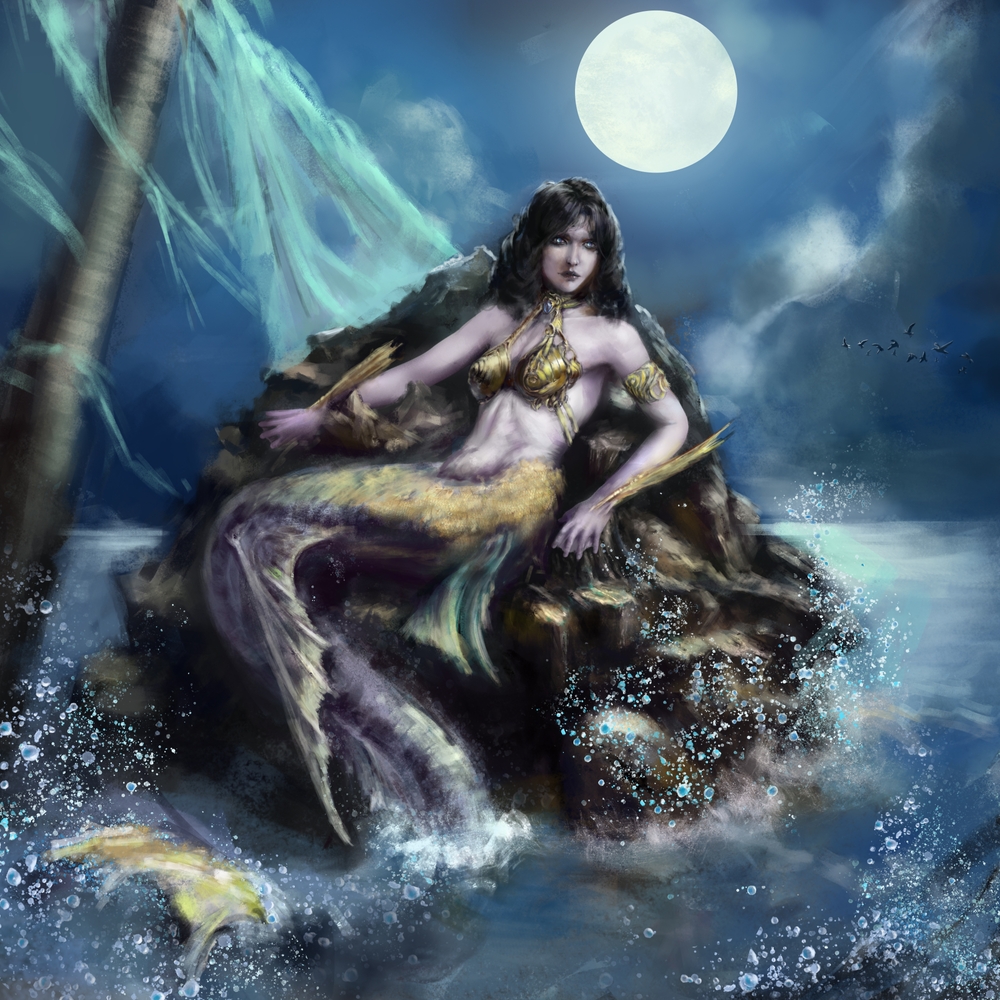
In the captivating and richly woven tapestry of Greek mythology, the Sirens hold a special place as enigmatic and seductive creatures. Often depicted as beings with the heads of women and the bodies of birds, the Sirens embody the deadly allure that can lead to downfall. Their story, interwoven with themes of temptation, danger, and the cleverness needed to evade it, is most famously illustrated in the epic journey of Odysseus.
The Allure of the Sirens
The Sirens were known for their hauntingly beautiful song, a melody so compelling that sailors were irresistibly drawn to it. Their music, filled with magical qualities, had the power to enchant anyone who heard it, leading them off course and into peril. The Sirens' song was a true test of will and wisdom, representing the seductive allure of veering away from life’s path in pursuit of fleeting pleasures.
The Nature of the Sirens
While commonly depicted as part woman and part bird, interpretations of the Sirens’ appearance and origin have varied throughout Greek mythology. Some myths suggest they were handmaidens of the goddess Persephone, transformed by Demeter or Aphrodite as a punishment or out of grief. This transformation theme resonates with many myths, where physical form often reflects inner turmoil or divine retribution.
The Encounter with Odysseus
The most notable encounter with the Sirens comes from Homer's "Odyssey," where the hero Odysseus, advised by the sorceress Circe, creates a plan to safely pass the Sirens' island. He orders his men to plug their ears with beeswax and instructs them to bind him to the mast, allowing him to hear the Sirens' song without succumbing to its allure.
This highlights a theme central to Greek mythology and the Odyssey in particular: the hero's journey and the challenges faced on the path to homecoming.
The Symbolism of the Sirens' Song
The Sirens and their song symbolise the distractions and dangers that can lead people astray from their path and goals. Their enchanting music represents the temptation to abandon duty and rationality to pursue pleasures. The Sirens' song is a test of resolve and is a timeless metaphor for the trials and temptations faced in life's journey.
The Legacy of the Sirens
The Sirens symbolise irresistible allure and deceptive danger, transcending Greek mythology to become a universal metaphor. They have inspired countless works of art, literature, and music, showing the timeless struggle between duty and desire, wisdom and folly.
6. The Harpies: Winged Spirits of Punishment
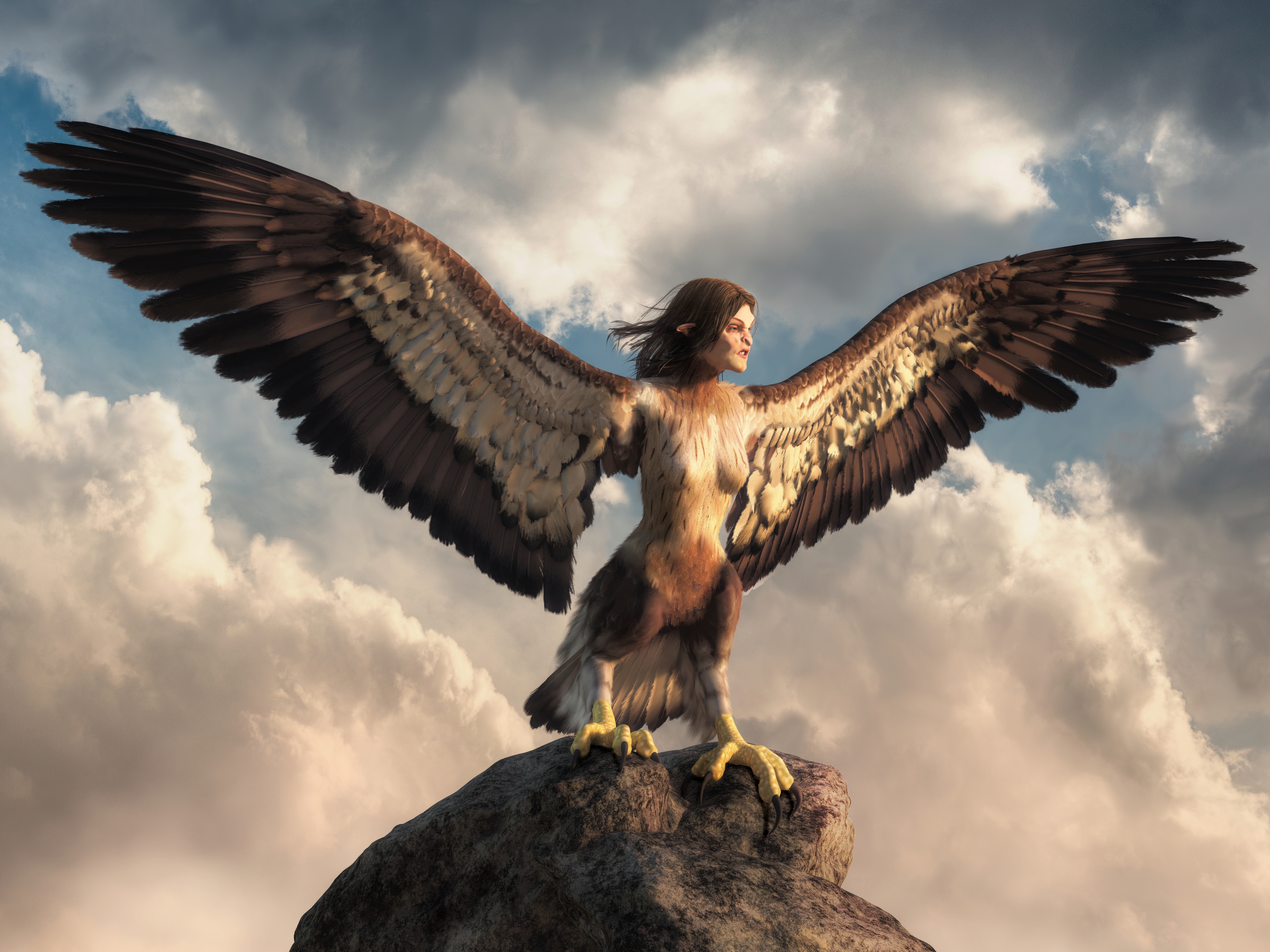
The Harpies hold a distinct and ominous place in the pantheon of Greek mythological creatures. Known for their women's faces and birds' bodies, these winged spirits served as agents of punishment, embodying the swift and often merciless nature of divine justice. Their roles in various myths illustrate the ancients' understanding of retribution and the inescapable nature of fate.
The Nature and Origin of the Harpies
The Harpies, whose name means "snatchers" or "swift robbers," are often depicted as having the heads of women and the bodies of birds, with large wings and sharp claws. They are believed to be the daughters of Thaumas and the Oceanid Electra, making them sisters of Iris, the goddess of the rainbow. This connects them to the elemental powers of sea and sky, highlighting their role as forces of nature employed by the gods.
Agents of Divine Retribution
In Greek mythology, the Harpies were primarily seen as instruments of punishment. They were dispatched by the gods, particularly Zeus and Hera, to exact vengeance or inflict suffering upon mortals who had done wrong. This could involve snatching people away to the underworld or tormenting them, as seen in the story of King Phineus. The Harpies were known to steal food, befoul their victims’ surroundings, and relentlessly hound those they pursued, making them feared symbols of unavoidable punishment.
The Harpies in Mythological Tales
One of the most notable appearances of the Harpies is in the myth of King Phineus of Thrace, a seer who Zeus punished for revealing too much of the future to mortals. The Harpies were sent to torment him by snatching away his food, leaving him in a constant state of hunger. This punishment was only over when the Argonauts, on their quest for the Golden Fleece, intervened and negotiated a truce.
In another myth, the Harpies were involved in the punishment of the prophetess Cassandra. After she spurned Apollo's advances, he cursed her so that her prophecies, though accurate, would never be believed. The Harpies played a role in enforcing this curse, contributing to Cassandra's tragic fate.
Symbolism and Impact in Mythology
In their role as punishers, the Harpies symbolise the inescapable nature of divine retribution. They represent the consequences of defying the gods or attempting to escape your fate. As creatures of the wind, they also symbolise the speed and certainty with which justice—or vengeance—can be delivered.
Their presence in mythology adds a layer of dread and awe, reminding mortals of the gods' power. The Harpies, therefore, stand as a cautionary symbol of the balance between human actions and divine will, a common theme in many Greek myths.
7. Chimaera: The Fire-Breathing Hybrid
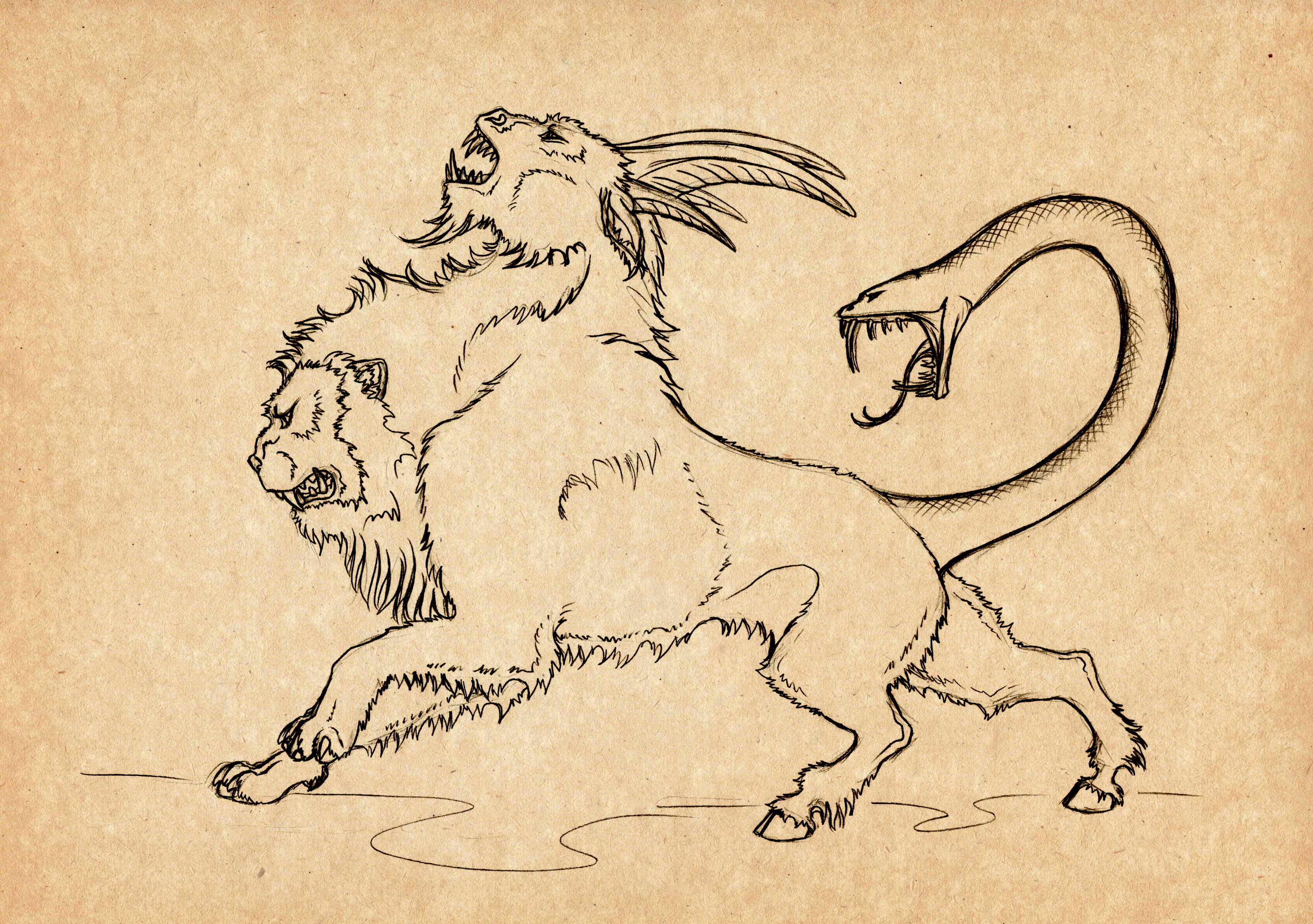
A composite being, blending the features of a lion, a goat, and a serpent, the Chimaera's very form symbolises the unpredictable and often fearsome nature of the mythical world. It's a tale of danger, courage, and the triumph of heroism over seemingly impossible odds.
The Anatomy of Terror: Chimaera's Composition
The Chimaera's description in mythology is both fascinating and horrifying. Its front part was that of a lion, often considered the king of beasts and a symbol of strength and courage. The middle part was that of a goat, a creature associated with stubbornness and vitality. The tail was that of a serpent, commonly linked with cunning and the potential for lethal venom.
Some versions even attribute the ability to breathe fire to the lion's mouth, adding to its fearsome reputation. This blend of fearsome animals made the Chimaera a unique and terrifying monster in Greek mythology, embodying various strengths and threats.
The Chimaera's Reign of Terror in Lycia
The Chimaera was said to have terrorised the region of Lycia in Asia Minor, spewing fire and wreaking havoc. Its seemingly invincible nature made it a constant fear and distress for the inhabitants. The creature's ability to breathe fire, which it shares with dragons from other mythological traditions, symbolised destruction and chaos.
Bellerophon and the Conquest of the Chimaera
The hero of the Chimaera's story is Bellerophon, a figure known for his bravery and adventurous spirit. His quest to slay the Chimaera required divine intervention and assistance. The hero rode the winged horse Pegasus, a gift from the goddess Athena, which symbolises the elevation of human ambition and capability through divine aid.
Bellerophon's victory over the Chimaera was achieved through his bravery, ingenuity, and the gods' support, illustrating the fascinating nature of heroism in Greek mythology.
The Symbolism of the Chimaera's Defeat
The defeat of the Chimaera by Bellerophon represents the triumph of human courage and resourcefulness over seemingly impossible challenges. The Chimaera, as a blend of various fearsome beasts, can be seen as a metaphor for complex challenges in life. Bellerophon's success symbolises the potential for overcoming even the most daunting obstacles, a recurring theme in many hero myths.
The Legacy of the Chimaera in Myth and Culture
The Chimaera's legacy extends beyond its mythological origins. It has come to symbolise anything wildly fanciful, improbable, or composed of incongruous parts. The term 'chimerical' describes impossible fantasies or unrealistic ideas, drawing directly from the mythical creature's extraordinary and fearsome nature.
8. The Sphinx: The Riddler of Thebes
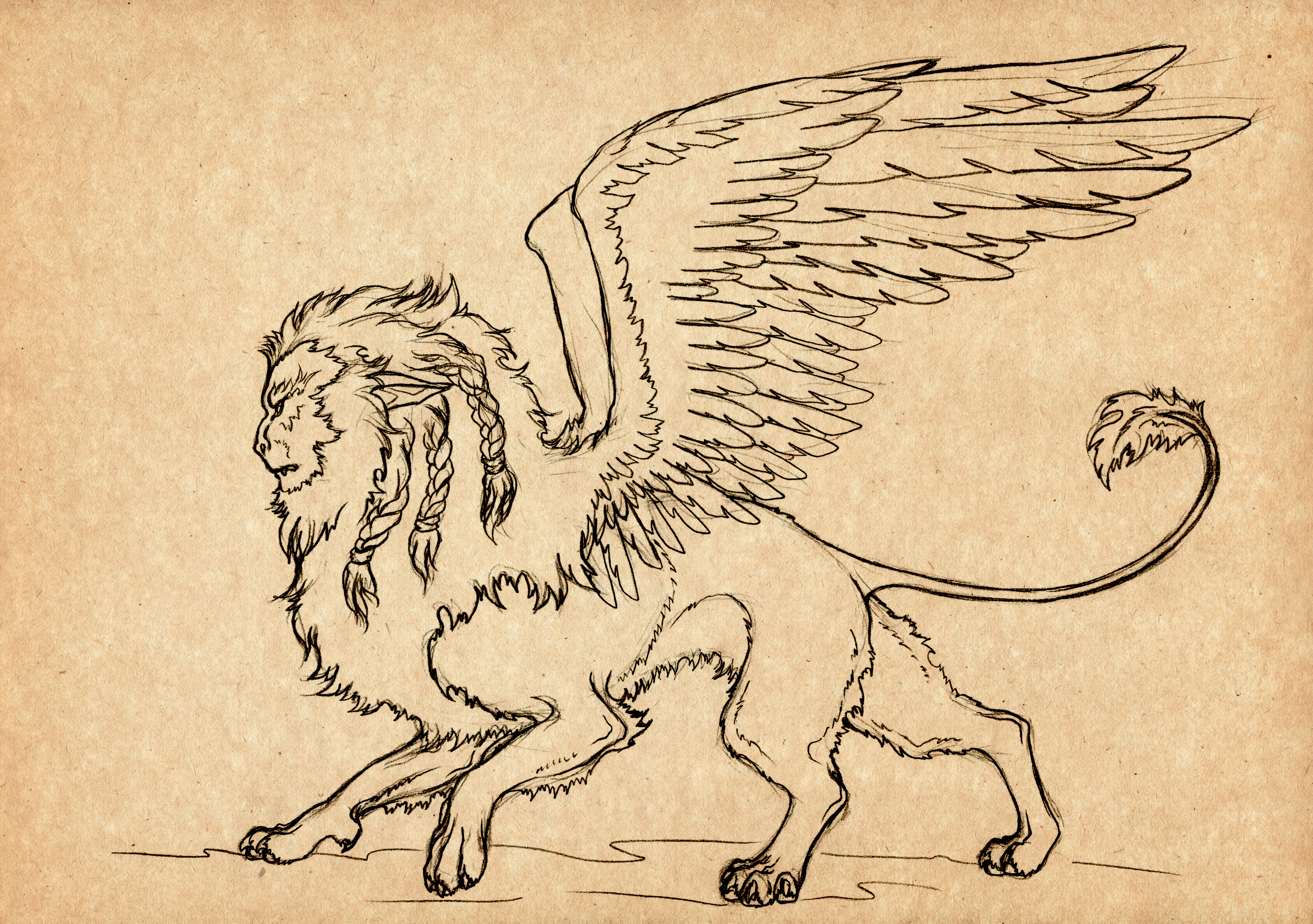
Known primarily for the deadly riddle she posed to the people of Thebes, the Sphinx was a creature with a woman's head, a lion's body, and a bird's wings. Her story intertwines themes of wisdom, cunning, and the often cruel twists of fate that define many Greek myths.
The Enigmatic Appearance of the Sphinx
The Sphinx's appearance itself was a riddle. She combined the nobility and strength of a lion, a bird's freedom and power, and a human's intelligence and face. This combination made her not just a physical threat but a symbol of deeper, more complex challenges. The human head indicated intelligence and understanding, the lion's body indicated physical strength, and the bird's wings symbolised freedom and the ability to move between worlds.
The Sphinx's Riddle and Reign of Terror
The Sphinx is most famous for the riddle she posed to the citizens of Thebes, a riddle given to her by the Muses. She sat outside the city, asking the same question to all who passed by: "What walks on four feet in the morning, two feet at noon, and three feet in the evening?" Those unable to answer correctly were killed and devoured by her, casting a shadow of fear and despair over Thebes. This riddle reflected on the human condition and the journey of life.
Oedipus and the Sphinx's Downfall
Oedipus answered the Sphinx's riddle correctly: "Man: as an infant, he crawls on all fours; as an adult, he walks on two legs; and in old age, he uses a 'walking' stick." Oedipus's ability to solve the riddle, which had baffled and doomed many before him, demonstrated his understanding of the human journey from birth to death.
Upon hearing the correct answer, the Sphinx, thrown into despair or perhaps bound by some divine decree, destroyed herself, liberating Thebes from her reign of terror.
The Sphinx in Greek Culture and Beyond
The story of the Sphinx and her riddle has become a cornerstone of Greek mythology, symbolising the perils of human intelligence and the mysteries of the human condition. In its simplicity and depth, the Sphinx's riddle has transcended its mythological origins to become a symbol of intellectual challenge and the understanding of life's stages.
Symbolism and Legacy of the Sphinx
The Sphinx's tale is rich in symbolic meaning. She represents the challenges of wisdom and knowledge and the inescapable realities of human life. Her story reminds us that even the most perplexing challenges can be overcome with insight and understanding.
9. Scylla and Charybdis: Terrors of the Sea Strait
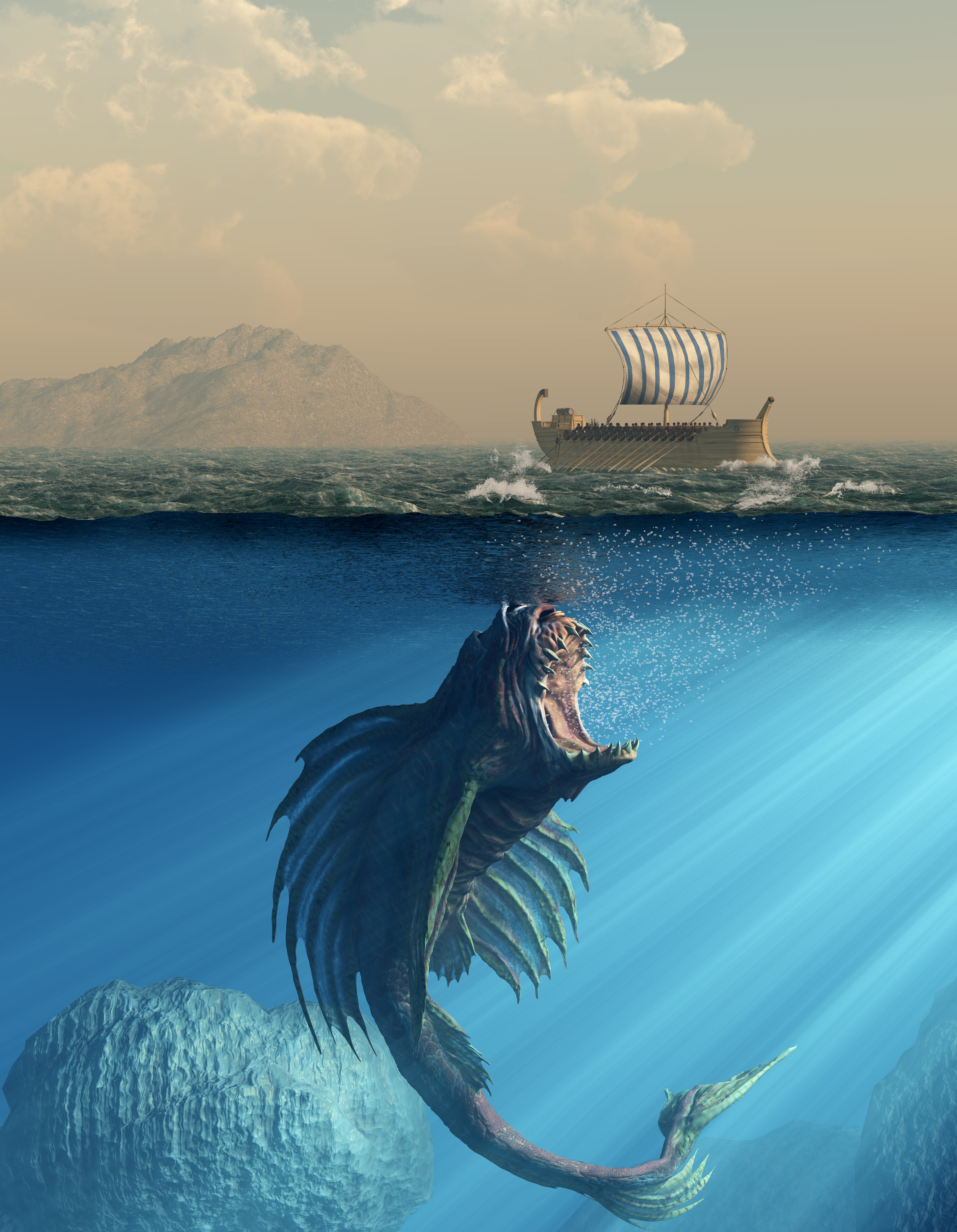
Scylla and Charybdis are two sea monsters on opposite sides of a narrow strait. They presented a lethal challenge to passing sailors, embodying the treacherous nature of sea voyages in ancient times. Their story is most famously interwoven with the epic journey of Odysseus, dramatically representing the difficult choices and dangerous predicaments you might face in life.
Scylla: The Multi-Headed Menace
Scylla, often described as a creature with six heads on long, snaking necks, each with a mouth full of sharp teeth, was a terror to all who sailed near her. Perched on a high cliff, she would snatch sailors from their ships, devouring them before they could react.
According to some myths, Scylla was once a beautiful nymph transformed into a monster by a jealous Circe or another deity, adding a tragic dimension to her ferocity. Her transformation and actions symbolise the suddenness with which fortune can turn and the peril that can arise from envy and spite.
Charybdis: The Whirlpool of Doom
Directly across from Scylla was Charybdis, a monstrous whirlpool personified as a sea creature. She was said to swallow vast amounts of water three times a day before spewing it back out, creating whirlpools capable of dragging entire ships to the ocean depths.
In her relentless and predictable cycle of destruction, Charybdis represented the inescapable natural disasters that could strike without warning, embodying the capriciousness and raw power of nature.
The Odyssean Dilemma: Navigating Between Two Evils
The most famous encounter with Scylla and Charybdis is recounted in Homer's "Odyssey." Odysseus, on his long journey home from the Trojan War, was advised by the sorceress Circe to steer closer to Scylla, accepting the loss of a few sailors, rather than risk the entire ship to Charybdis' whirlpool.
This harrowing passage, where Odysseus had to choose between two deadly options, represents the idiom "between a rock and a hard place," reflecting the tough choices you sometimes have to make, where both options lead to undesirable outcomes.
Symbolism and Legacy of Scylla and Charybdis
Scylla and Charybdis symbolise the unpredictable and often cruel challenges of the natural world. They also represent that navigating life's journey often involves difficult choices, where safety lies in choosing the lesser of two evils.
10. Typhon: The Father of All Monsters
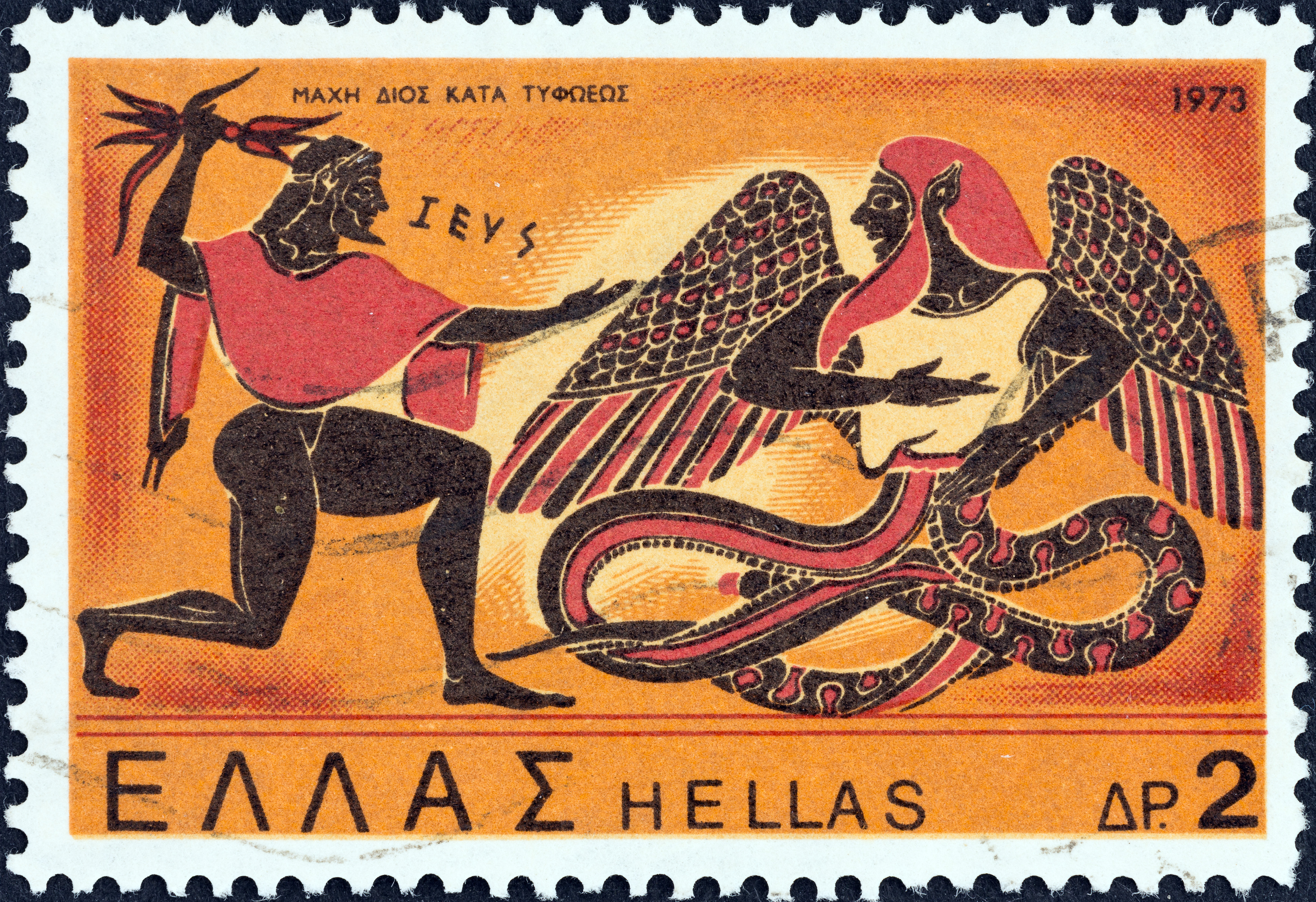
Typhon is a figure of unparalleled terror and destruction in Greek Mythology. Often referred to as the father of all monsters, his formidable presence in these ancient tales represents the ultimate embodiment of chaos and the primal forces of nature.
His clashes with the Olympian gods, especially Zeus, are among Greek mythology's most dramatic and defining moments, illustrating the eternal struggle between order and chaos.
The Fearsome Nature of Typhon
Typhon's description in mythology is that of a monstrous giant, often depicted as a serpent or with serpentine features.
He was said to be of such immense size that his head touched the stars, and his hands could reach the east and west horizons. He had numerous heads, each capable of breathing fire, and his roar was so terrifying that it caused panic among gods and mortals alike. Typhon's essence was that of destruction and fear, making him one of the most dreaded figures in Greek mythology.
The Origins of Typhon
Typhon was believed to be the son of Gaia (Earth) and Tartarus (the deep abyss). His birth was Gaia's response to the defeat of the Titans, her older children, by the Olympian gods. Typhon's creation was a direct challenge to the Olympian order, a force of chaos rising against the established rule of Zeus and his siblings.
The Epic Battle with Zeus
The most notable aspect of Typhon's myth is his cataclysmic battle with Zeus, the king of the Olympian gods. This confrontation represents the struggle between order (Zeus) and chaos (Typhon).
The battle was ferocious and earth-shaking, with Typhon initially overpowering Zeus and severing his sinews. However, Zeus was restored to full strength through the help of Hermes and Pan, and he eventually defeated Typhon after a long and epic struggle. This victory solidified Zeus's position as the supreme deity of the Greek pantheon and symbolised the triumph of order over chaos.
Typhon's Legacy in Greek Mythology
Typhon's defeat did not erase his impact on Greek mythology. He is often cited as the father of many monstrous creatures, including the Hydra, the Nemean Lion, and Cerberus, each of whom continued to represent the chaotic and destructive aspects of the world in their own stories.
The figure of Typhon has transcended Greek mythology to become a symbol of power and chaos, often referenced in literature and art as a representation of overwhelming and destructive forces.
Symbolism and Impact of Typhon
The story of Typhon is rich in symbolic meaning. He represents nature's primal and untamed forces constantly challenging the ordered world. His battle with Zeus symbolises the ongoing struggle between stability, upheaval, order, and disorder. Typhon's enduring presence in mythology reminds us of the tension between these opposing forces and the fragility of the order we often take for granted.
11. Echidna: Mother of Monsters

Echidna occupies a unique and formidable position as the "Mother of Monsters." Her figure, part woman and part snake is as intriguing as it is terrifying, encapsulating the ancients' fascination with hybrid creatures.
The Hybrid Nature of Echidna
Echidna's humanoid upper half represents intelligence, cunning, and the potential for seduction, while her serpentine lower half symbolises danger, mystery, and an association with the realms of the earth. This duality in her nature made her a formidable figure in Greek mythology, embodying the merging of human-like intellect with the primal ferocity of a beast.
Echidna and Typhon: A Monstrous Union
Echidna was the mate of Typhon, another titan of Greek mythology known for his role as the epitome of chaos and destruction. Their union brought forth a lineage of monstrous beings, each embodying various aspects of their terrifying parentage.
In her role as a mother, Echidna nurtured and unleashed these creatures upon the world, contributing to the chaos that the heroes of mythology would have to contend with.
Progeny of Echidna: A Legacy of Terror
Echidna's offspring are among the most famous and feared in all Greek mythology. These include:
- The Nemean Lion: A beast with impenetrable fur, slain by Hercules as part of his Twelve Labours.
- The Hydra: The multi-headed serpent that regrew two heads for each one cut off, also defeated by Hercules.
- Cerberus: The three-headed dog guarding the entrance to the underworld.
- Chimera: A fire-breathing hybrid creature composed of parts of a lion, goat, and serpent.
Each of these monsters presented unique challenges to the heroes and gods of Greek mythology, contributing to the rich tapestry of tales passed down through the ages.
Echidna's Role in Greek Mythology
Echidna's role extends beyond merely being the mother of various monsters. She represents the mysterious and dangerous aspects of the world that the ancient Greeks sought to understand and explain through their myths. As a figure lurking in the shadows, she embodies the unknown perils that lie just beyond the boundaries of the known world, challenging heroes and mortals alike.
The Symbolism and Impact of Echidna
The figure of Echidna in Greek mythology is a powerful symbol of the untamed and difficult aspects of the natural world. Her legacy through her monstrous children highlights the recurring theme in Greek mythology of confronting and overcoming fearsome challenges. As the mother of some of the most daunting creatures in mythology, Echidna's story intertwines with those of many heroes, illustrating the interconnectedness of life, struggle, and the pursuit of order amidst chaos.
12. The Nemean Lion: Hercules' First Labour
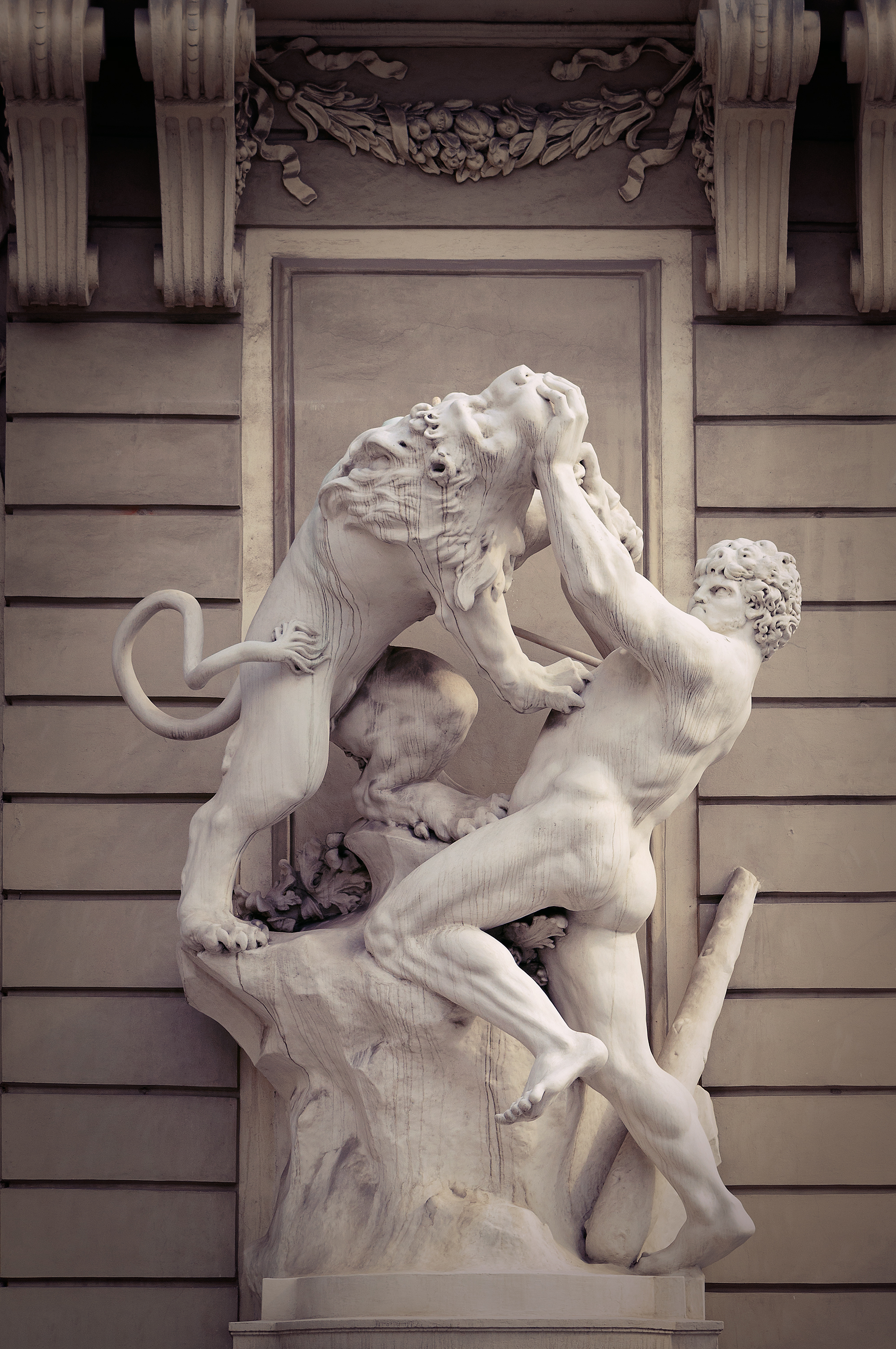
The Nemean Lion is one of the most iconic beasts ever confronted by a hero. This monstrous lion, known for its impenetrable skin and fearsome strength, was the formidable adversary Hercules faced in the first of his Twelve Labours. The tale of Hercules and the Nemean Lion is a narrative that combines courage, intelligence, and resilience, qualities epitomising the essence of heroism in Greek mythology.
The Indomitable Beast of Nemea
The Nemean Lion was more than just a creature of strength and ferocity. It symbolised insurmountable challenges, possessing a hide so tough that no weapon could pierce it. This extraordinary trait made the lion an almost unbeatable opponent, terrorising the region of Nemea. According to some myths, the lion was a child of Echidna and Typhon, or it was said to have been sent by Hera, Zeus's wife, to challenge Hercules.
Hercules' Task: A Test of Heroism
The task of slaying the Nemean Lion was the first job assigned to Hercules by King Eurystheus. This was not merely a test of Hercules' physical strength but also his resourcefulness and determination. The lion's impenetrable skin meant that Hercules had to think beyond conventional means of combat, highlighting the necessity of wit, strategy, and physical prowess.
The Battle and Triumph
Hercules' encounter with the Nemean Lion is a classic depiction of a hero's struggle against overwhelming odds. After realising that his arrows were ineffective against the lion's hide, Hercules decided to confront the beast in hand-to-hand combat. In a display of extraordinary bravery and strength, Hercules wrestled with the lion and eventually strangled it to death, using his immense power to overcome what seemed like an indestructible obstacle.
The Lion's Hide: A Symbol of Victory
After slaying the Nemean Lion, Hercules skinned the beast using its own claws, which were the only things sharp enough to cut through its hide. He then wore the lion's skin as a cloak and its head as a helmet, turning the symbol of his first great challenge into a symbol of his victory and protection. The lion's skin became Hercules' most recognisable attribute in art and literature, a testament to his heroic status and triumph over the impossible.
Legacy of the Nemean Lion in Greek Mythology
The story of the Nemean Lion and Hercules' victory over it established Hercules as the quintessential hero of Greek mythology. It underscored the themes of courage, intelligence, and spirit required to face and overcome daunting challenges. The Nemean Lion's legacy symbolises the extraordinary challenges that heroes must confront and conquer.
13. The Griffin: The Majestic Beast
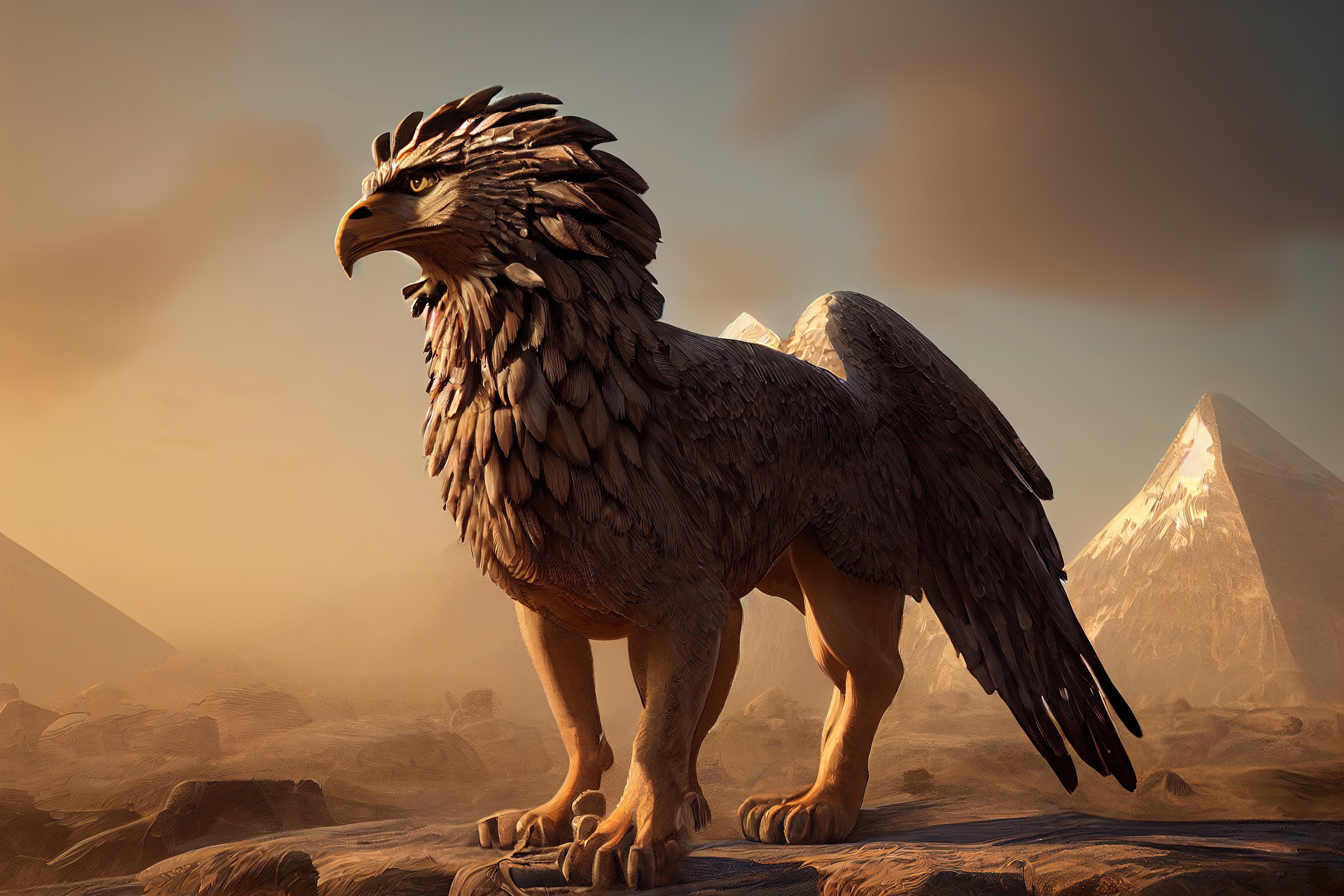
The Griffin captures the imagination with its majestic and awe-inspiring form. This mythical beast, possessing a lion's body and an eagle's head and wings, represents a harmonious blend of two of nature's most revered animals. In the ancient world, the Griffin symbolised divine power and guardianship, embodying qualities that transcended the ordinary.
The Symbolic Convergence of Lion and Eagle
In the Griffin, the strengths and characteristics of the lion and the eagle are uniquely combined. The lion, regarded as the king of beasts, symbolises strength, courage, and authority. The eagle, known as the king of the skies, represents vision, speed, and a soaring spirit. Together, these aspects make the Griffin a powerful symbol of terrestrial and aerial mastery, dominating over land and sky.
The Griffin in Greek Mythology
In Greek mythology, Griffins were often depicted as guardians of sacred or precious things. They were believed to watch over gold and treasures, and their presence was thought to ward off evil and protect from harm. When combined, the Griffin's role as a guardian can be interpreted as a metaphor for vigilance and the protective nature of intelligence and strength.
The Griffin's Role in Ancient Cultures
While the Griffin is well known in Greek mythology, its presence is found in various ancient cultures, each attributing different symbolic meanings to this magnificent creature. In some cultures, Griffins were associated with divine power and protection, often depicted in art and sculpture as symbols of strength and guardianship. Their representation in various cultures highlights the universal appeal and fascination with this mythical creature.
The Griffin's Influence in Art and Literature
The Griffin has been a source of inspiration in art and literature throughout history. Its striking appearance and symbolic power have made it a popular subject in sculptures, paintings, and literary works. The Griffin is often used to convey a sense of majesty, authority, and protection, making it a lasting symbol in both historical and contemporary works.
The Griffin as a Symbol of Unity and Power
The Griffin's combination of eagle and lion attributes can also symbolise unity and the amalgamation of different strengths. It represents the idea that a union of diverse qualities can lead to a greater whole, a creature more formidable and awe-inspiring than its individual parts. This symbolism extends beyond mythology into human aspiration, representing the ideal of harmonising different strengths and virtues.
Recommended for you!
Best SellersGreek Monsters in Mythology: Frequently Asked Questions
Who is the Greek Goddess of Monsters?
Echidna is often referred to as the Greek goddess of monsters. She is a central figure in Greek mythology because she is the mother of many of the most feared mythical creatures.
What Greek Monster Has 100 Eyes?
Argus Panoptes, known simply as Argus, is the Greek monster famous for having 100 eyes. He was a giant watchman, making him an excellent guardian because he could see in multiple directions at once.
What is the Creepiest Greek Myth?
The story of Medusa, with her snake-covered head and petrifying gaze, is often considered one of the creepiest Greek myths. The transformation of a beautiful woman into a monstrous Gorgon adds a layer of tragedy to her terrifying tale.
Who is the Most Violent Greek God?
Ares, the god of war, is often considered the most violent of the Greek gods. Unlike Athena, who symbolises strategic and tactical warfare, he represents the brutal and bloody aspects of conflict.
Who is the Darkest Greek God?
Hades, the god of the underworld, is often perceived as the darkest Greek god due to his association with death and the afterlife. However, Hades' role was more about ruling the dead rather than being evil.
What Greek Monster Has 6 Heads?
Scylla, a formidable sea monster in Greek mythology, is known for having six heads. She resided in the Strait of Messina, opposite the whirlpool Charybdis, posing a deadly threat to sailors navigating the narrow passage.
What is the Weirdest Greek God?
Pan, the god of the wild, shepherds, and flocks, with his half-man, half-goat appearance, is often considered one of the weirdest Greek gods. His peculiar attributes, connection to nature, and penchant for mischief make him a unique figure in Greek mythology.
What Greek Monster Has 9 Heads?
The Hydra, specifically the Lernaean Hydra faced by Hercules in his Twelve Labours, is often depicted as having nine heads. However, the number of heads varies in different myths, with some accounts describing an ever-increasing number each time a head was cut off.
Who Are the Greek Demons?
In Greek mythology, the term 'demon' (daimon) didn't necessarily refer to evil entities. It was often used to describe a range of spirits or divine powers. However, creatures like the Erinyes (Furies), spirits of vengeance, could be considered demonic figures due to their terrifying roles.
What Greek Monster is Half Man Half Horse?
The Centaur is a famous Greek monster that is half man, half horse. These creatures were known for their wild and uncivilised behaviour, though a few, like Chiron, were wise and noble.
What is the Biggest Monster in Greek Mythology?
Typhon, often considered the father of all monsters, is the biggest monster in Greek mythology. His immense size and strength made him a fearsome opponent, even for the Greek gods.
What Greek Creature is Half Woman Half Bird?
The Harpies, with their women's faces and birds' bodies, fit this description. They were known as winged spirits of wind and were often depicted carrying off evildoers or tormenting individuals.
What Greek Monster Guards the Golden Fleece?
The Dragon of Colchis, sometimes called a serpent, guarded the Golden Fleece in the myth of Jason and the Argonauts. This creature was known for its vigilance and deadly prowess.
Who is the Greek God of Monsters?
While there is no specific Greek god of monsters, in Greek mythology, Typhon is often considered the father of many monsters. However, gods like Hades and Poseidon are associated with various mythical creatures.
What Creature in Greek Mythology Has One Eye?
The Cyclopes are the one-eyed giants in Greek mythology. The most famous of these, Polyphemus, was encountered by Odysseus during his voyages. These creatures were known for their strength and were said to be skilled craftsmen.
Study Greek Mythology for £29
Discover more about ancient legends with our Greek Mythology Diploma Course.
What You'll Learn
- Stories of Gods and Heroes: Uncover the tales of Olympian gods, demigods, and heroes, exploring their intricate relationships, powers, and the moral lessons they convey.
- The Saga of Mythical Creatures: Dive deep into the tales of legendary creatures like the Minotaur, Medusa, and the Hydra, understanding their symbolism and impact on Greek culture.
- The Art of Myth-Making: Gain insights into how these myths were crafted and have evolved, influencing art, literature, and philosophy across centuries.
Special Offer
In line with our commitment to learning and personal growth, we are excited to offer the Greek Mythology Diploma Course for a discounted price of £29!










